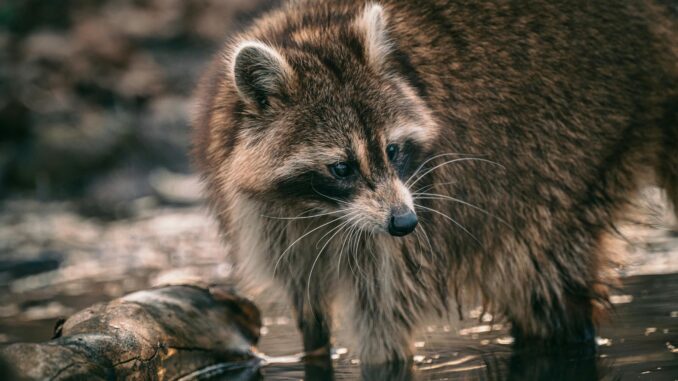
Wondering if raccoons venture out during rainstorms? The answer is yes—raccoons are known to be active even in wet conditions. These adaptable creatures, recognized for their distinctive masked appearance, display behaviors that enable them to navigate various weather conditions, including rain.
In this blog post, we’ll explore the behavior of raccoons in wet weather and uncover whether rain hinders or enhances their activities.
Table of Contents
Do Raccoons Come Out in the Rain
Raccoons are nocturnal animals and may come out in the rain as it doesn’t significantly affect their activity patterns. They are adaptable and often forage for food in various weather conditions.
Light Rain
Raccoons are largely unaffected by light rains, as their water-resistant fur and nocturnal habits enable them to navigate wet conditions comfortably. In fact, they may even become more active during rain, taking advantage of increased foraging opportunities.
Heavy Rain
While heavy rain may prompt raccoons to seek temporary shelter, their resourcefulness enables them to find alternative ways to stay dry, such as using overhangs or urban structures.
Despite the downpour, raccoons may still venture out in search of food, taking advantage of the increased availability of prey brought to the surface by the rain. Overall, heavy rain only temporarily influences their behavior, and they remain well-suited to thrive in various weather conditions.
Why Do Raccoons Come Out in the Rain?
- Water-Resistant Fur: Raccoons possess water-resistant fur that allows them to stay relatively dry during rain, enabling them to comfortably navigate wet conditions.
- Nocturnal Behavior: Raccoons are primarily nocturnal, and rain doesn’t significantly deter their nighttime activities. In fact, they may become more active during rain, seizing the opportunity for increased foraging.
- Increased Foraging Opportunities: Rain can bring earthworms, insects, and other prey to the surface, creating a buffet for raccoons. This abundance of food motivates them to venture out in search of a meal.
- Adaptability: Raccoons are highly adaptable creatures, capable of thriving in various environments, including rainy weather. Their ability to adjust to changing conditions contributes to their resilience.
- Urban Adaptation: Raccoons have adapted to urban environments, and rain doesn’t dissuade them from navigating through human-made structures in search of food or shelter.
Do Raccoons Like Rain?
While raccoons may not explicitly “like” rain in the way humans enjoy sunny days, they are well-equipped to handle wet conditions. Their water-resistant fur, coupled with their opportunistic and adaptable nature, allows them to make the most of rainy weather. The increased availability of food during rain makes it a favorable time for raccoons, and their behavior suggests that they are not averse to the challenges posed by wet conditions.
Where Do Raccoons Go When it Rains?
When it rains, raccoons exhibit various behaviors to seek shelter and adapt to the wet conditions. Here are common places where raccoons may go when it rains:
- Natural Shelters: Raccoons seek refuge in tree hollows, dense vegetation, or secluded spots during rain.
- Urban Structures: They utilize abandoned buildings, attics, or under decks to escape the rain in urban areas.
- Overhangs and Eaves: Raccoons find cover under overhangs or eaves for partial protection from rain.
- Storm Drains and Sewers: During heavy rain, raccoons may seek shelter in storm drains or sewer systems.
- Dense Foliage: They use areas with dense foliage to shield themselves from rain.
- Nesting Sites: Female raccoons retreat to tree hollows or dens to protect their young from rain.
- Temporary Dwellings: Raccoons create impromptu shelters using leaves or twigs for temporary rain protection.
What Temperature Do Raccoons Like
Raccoons are adaptable to various temperatures, but they typically prefer moderate climates. They thrive in temperatures ranging from 40 to 70 degrees Fahrenheit. However, they can endure colder or warmer conditions and may adjust their behavior to the seasonal changes, seeking shelter in extreme weather.
Raccoon Behavior in Different Weather Conditions
| Weather Condition | Activity Level |
| Sunny | High |
| Cloudy | Moderate |
| Rainy | Moderate |
| Stormy | Reduced |
Frequently Asked Questions (FAQs) About Raccoons and Rain
Q1: Why do raccoons come out in the rain?
A: Raccoons come out in the rain because their water-resistant fur allows them to navigate wet conditions comfortably. Rainfall often increases foraging opportunities as it brings prey to the surface, motivating raccoons to venture out in search of food.
Q2: Do raccoons have specific rain shelters?
A: While raccoons may seek shelter under overhangs or urban structures during heavy rain, they are adaptable and use various spots like tree hollows, dense vegetation, or even storm drains to stay dry.
Q3: How do raccoons stay warm in the rain?
A: Raccoons rely on their water-resistant fur to stay relatively dry in the rain. This fur acts as a natural barrier, preventing water from reaching their skin and helping them maintain body warmth.
Q4: Can heavy rain disrupt raccoons’ nocturnal activities?
A: While heavy rain may prompt raccoons to seek temporary shelter, their resourcefulness often allows them to find alternative ways to stay dry. They may still be active during rain, adapting their behavior to the weather conditions.
Q5: Do raccoons in urban areas behave differently in the rain than those in natural environments?
A: Raccoons in urban areas may use structures like rooftops and parks as rain shelters, showcasing their adaptability. However, even in natural environments, raccoons tend to remain active during rain, capitalizing on the increased availability of food.
Conclusion:
Raccoons display remarkable adaptability to rain, seamlessly navigating through wet conditions. As opportunistic creatures, they adeptly balance the challenges posed by rain, highlighting their ability to coexist with diverse elements in both wild and urban landscapes. Raccoons, with their unique traits, continue to fascinate observers as they effortlessly embrace the complexities of their environments.
